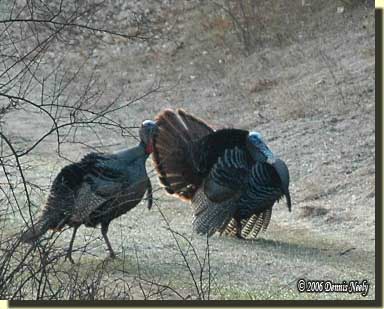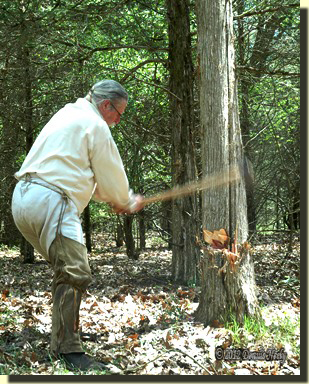Retaliation extracted a tolerated agony. Thorns poked, prodded and prickled. Mosquitoes buzzed about. The trade blanket, pulled tight as in a winter squall, offered some protection from itchy welts, but the cost was excessive heat, dripping perspiration and dehydration. In the humidity of that May morning, in the Year of our Lord, 1792, the woodsman wondered, “Why this sacrifice?”
Wednesday morning, the day prior, a dominant gobbler, two lesser toms and two jakes responded to the post hunter’s draws on the single wing-bone. Four birds exited the hardwoods and marched to the knoll in the little meadow. Their fanning, strutting and spinning, all in silence, lasted a half hour. None of those tender morsels ever ventured within the effective distance of the Northwest trade gun.
With the sun above the eastern tree line, a good-sized hen turkey walked around the broken-down apple tree and angled into the meadow. She kept her distance, uttered one putt, loud and strong, then turned about and pecked her way back to the meadow’s north edge. The four toms folded their traveling show and followed. The fifth gobbler, the wily one, pursued, too, but from a clump of red cedar trees, twenty-one paces behind the frustrated woodsman.
That evening, the tom turkeys roosted in a forked oak that stood tall in a corner of Fred’s woods. The hunter knew that some mornings, after fly down, those gobblers descended the steep hillside, sipped at the pool beyond the nameless creek’s tiny waterfall and marched along the doe trail that skirted the east side of the great swamp.
Forty paces distant from the watering pool, the earthen path arched out around a fallen oak’s rotting skeleton. The trail’s course circled back around two large cedar trees and came close to a tangle of thorn bushes. A modest cedar tree with broad, drooping boughs grew among those brambles. Navigating to that fort was painful work.
The backcountry provider of meat heard the birds’ wings, heard the thumps, counted five. Many minutes passed before a solitary crunch in the brittle leaves started arteries throbbing. Crackles paused…began again…paused… A fox squirrel spiraled up a wild cherry tree, but its location was wrong for the oncoming sounds. “A clean kill, or a clean miss. Your will, O Lord,” the hunter mouthed.

A crunch…a pause…a crackle… The approach continued, but the thick underbrush afforded no visual contact with the perpetrator. The only avenue for a humane shot was straight down the hill at the doe trail. The death bees grew impatient. The longest hesitation came when the forest tenant stopped thirty paces or so to the east. Stoic stillness, nary a twitch or twinge, was the hunter’s only defense.
Then, with two quick bounds, an older doe reached the trail, between the pool and the rotted hulk. She sniffed, wiggled her ears and swatted flies with her wide white tail as she scanned the green cattails and sedge grass. Two more bounds, three splashes and a snapped twig put her half way to the south island.
The firelock’s sharp English flint eased to half-cock. The death bees slumbered. Buckskin-clad legs stretched out. The Northwest trade gun rested across the post hunter’s thighs. As he would discover later that morning, the long-bearded tom and his cohorts chose an easterly course, scratching and grubbing in the fresh tilled field behind the Denning homestead.
An Interesting Shelter Comparison
The journal scribblings for that traditional black powder hunting adventure tell of axing down two cedar trees late that morning. The goal was a fall lean-to shelter for the post hunter, but modern life got in the way of that project. I have restarted four times, and well…
So now I am again looking at resurrecting that project. I have two piles of cedar trees, and I hope to return to trimming and cutting-to-length by the end of July.

The subject of 18th-century shelter for three personas is a bit daunting. Msko-waagosh’s wigwam was destroyed in a wet, spring snowstorm in 1794. He will rebuild the wigwam in the same hollow, but with a different species of sapling. New canvas pieces will add to the old.
Mi-ki-naak’s peaked wigwam is awaiting horizontal ribs and a covering. The first choice is bark, consistent with the writings of James Smith. The problem is coming up with the bark. I do cut live trees just to harvest bark. That is inconsistent with the land management plan for the North-Forty, and contrary to my normal forestry practices. I have enough downed or dead trees to deal with. I don’t want to use canvas, but I fear I might have to.
A different research project sent me to George Nelson’s journal, My First Years in the Fur Trade. Like most of my go-to documentation, there are at least fifty sticky notes indexing important passages. After locating the passage I sought, I glanced at a note that said “Begin to Build.”
The entry was from September, 1802. There are two versions of Nelson’s explanation of how the trading house was constructed; the second being from his recollections recorded in 1836. Since shelters have been on my mind this spring, I paused and read:
“We did not make palaces: Ours was about 16 or 18 feet long made thus: We build up the two sides, to the height required, say five & a half, or perhaps six feet. These are secured by two stakes at each end, as a common rail fence, & braced by a good strong stick, the whole breadth of the house, & notched at each end, to lay on the two sides, to prevent their moving. The two trenches werein to plant or set the ends upright, & of the same size as the sides. Two strong posts in the middle, to receive a ridge pole, two & a half or 3 feet, higher than the sides, so that the roof, which consists of straight poles or split slabs, when the timber admits, may have sufficient slope for the water to run off. An opening is left at one end; that part below the cross stick or beam for a door, & the above for a window. The ends, being upright and secured by a pole, bound with good strong with[e]s, to prevent their falling. The whole is well plastered, the Shop only out-side, as some of it will fall & dirty our furs or spoil our grease, meat, &c. but the house is plastered on both sides, inside & out. The joints between the roofing is also plastered; carefully covered about a foot thick with grass which we cut with our knives, & four or five inches of ground thrown on to prevent its being blown off, also as a preservative against the fire. The window is made of the thinnest parchment skin we can procure. The chimney is one side of the house, part of stone, when handy, but most commonly of earth made into mortar & wrapped with grass. The doors of slabs, split with the ax and squared down. The floors, when good wood to rive [split] cannot be had is squared from trees & then dubbed off with an adze, when we have one, if none, then with the hoe, which we sharpen with the files, for we cannot take in grind stones. Our beds, two posts, at the head & foot with a stick fixed, one in the posts & the other in an augar hole (when we happen to have such article) or forced into one of the chinks of the house. The door is secured by a wooden latch, & a leather thong to raise it from the out side. Thus the house is finished, & sturdy simple enough it is…” (Nelson, 58 – 59).
The Burnett County Historical Society in Wisconsin reconstructed Nelson’s cabin based on this description. This would be a perfect trading post for Samuel the Trader, but alas, my alter egos already have three shelters to build. Perhaps another year, on the spot my father said he saw a dilapidated log cabin in his youth. There are five deep depressions in the soil at the location that have never been searched or metal detected. Plus the site is adjacent to a six-foot depression that my father was told was “the old Indian trail.”
It’s interesting to me that the returned captives included various types of shelters in their narratives, more so than the settlement hunters. James Smith tells of a “wintercabbin” constructed by his adoptive band in 1755:
“…Here they made their wintercabbin, in the following form. They cut logs about fifteen feet long, and laid these longs [logs] upon each other, and drove posts in the ground at each end to keep them together; the posts they tied together at the top with bark, and by this means raised a wall fifteen feet long, and about four feet high, and in the same manner they raised another wall opposite to this, at about twelve feet distance; then they drove forks in the ground in the centre of each end, and laid a strong pole from end to end on these forks; and from these walls to the poles, they set up poles instead of rafters, and on these they tied small poles in place of lathes; and a cover was made of lynn bark which will run even in the winter season…
“At the end of these walls they set up split timber, so that they had timber all round, excepting a door at each end. At the top, in place of a chimney, they left an open place, and for bedding they laid down the aforesaid kind of bark, on which they spread bear skins. From end to end of this hut along the middle there were fires, which the squaws made of dry split wood, and the holes or open places that appeared, the squaws stopped with moss, which they collected from old logs; and at the door they hung a bear skin; and notwithstanding the winters are hard here, our lodging was much better than what I expected…” (Smith, 44 – 46).
Many years ago I discussed tomahawk/ax patterns with a respected blacksmith, John Cummins. As we talked over the ax that I wanted him to make, I asked about time period. A polite smile crossed his face and he explained that for most axes and tomahawks a specific time period is difficult to nail down. The patterns became somewhat universal, because they worked well in the woods. “Don’t mess with success” was his comment. He went on to say a blacksmith would reach into his metal pile, pull out a piece of iron and shape it in a manner consistent with common practice in his locale. Thus the same pattern spanned decades of use by an assortment of owners.
When I started comparing Nelson’s description with that of Smith’s, John’s “Don’t mess with success” comment smacked me square in the face. The same shelter built by Native Americans was used for a trading house a half century later.
In essence, this log-wall and upright-post shelter construction style is “period-correct” for both Native Americans and traders alike in the Great Lakes region. Further, I would expect anyone coming into the wilderness would have had knowledge of this easy-up cabin, or they might have copied what they saw on their journey to the interior.
As much as these journal entries muddy the waters they also add to the available choices for backcountry shelters, taking into account the individual’s geographic location, time period and social standing. Context plays a role in the selection process, as does the specifics of the historical portrayal. But there is little doubt that careful research opens the door to more options and choices than it closes.
Give traditional black powder hunting a try, be safe and may God bless you.


